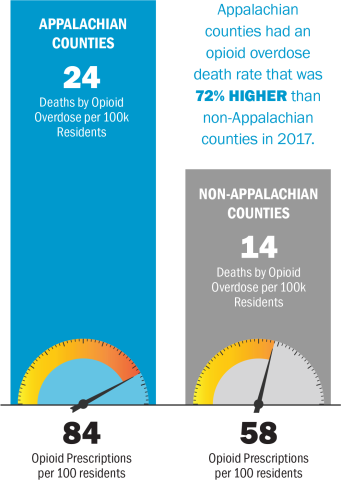Opioids in Appalachia: The Role of Counties in Reversing a Regional Epidemic
Upcoming Events
Related News
Across the nation, communities are suffering from rampant opioid misuse and overdose rates, and the 420 counties in the Appalachian region of the eastern U.S. have been disproportionately impacted by this epidemic of addiction. At the turn of the millennium, the opioid overdose death rate for Appalachian counties was roughly equal to that of the rest of the country. By 2017, however, the death rate for opioid overdoses in Appalachian counties was 72 percent higher than that of non-Appalachian counties.

Source: NACo Analysis of Centers for Disease Control and Prevention, National Center for Health Statistics, Multiple Cause of Death 1999-2017 on CDC WONDER Online Database; NACo Analysis of Centers for Disease Control and Prevention analysis of data from IQVIA Xponent 2006–2017. Available at www.cdc.gov/drugoverdose/maps/rxrate-maps.html.
Note: Age-adjusted death rates were calculated by applying age-specific death rates to the 2000 U.S. standard population age distribution. Death rates are deaths per 100,000 population (age-adjusted).
While the misuse of opioids is driven by unique and varying factors, the pronounced impact of the opioid epidemic in Appalachia may be related to socioeconomic indicators in which the region trails the rest of the country, including education, health, and income.
As leaders in their communities, Appalachian county officials are well-positioned to drive local efforts to overcome the opioid epidemic. They have authority and legitimacy from holding public office, coupled with empathy and trust from daily community involvement, and can leverage relationships with businesses, community organizations and other governments to enhance the community response to addiction. Given that Appalachian governments operated with 35% less per capita revenue than their non-Appalachian counterparts in 2012 ($1,184 vs. $1,831 respectively), the role of the region’s county leaders in crafting efficient and sustainable responses to the opioid epidemic is especially important. The recommendations and case studies contained in this report are designed to aid Appalachian county leaders in their efforts to formulate these responses.
Recommendations for Local Action
1. Exercise Strategic Local Leadership
Key Actions
- Set a tone of compassion in local conversations on opioids
- Convene diverse stakeholders and faith-based organizations to form Opioid Task Forces
- Foster regional and intergovernmental cooperation
Case Study: Ross County, Ohio
Case Study: Mercer County, W.Va.
2. Create and Strengthen Preventive and Educational Initiatives
Key Actions
- Increase public awareness and facilitate safe disposal sites for opioids
- Conduct community outreach to children and families, particularly within the education system
- Leverage data and technology to target services
Case Study: Allegany County, Md.
3. Expand Access to Addiction Treatments
Key Actions
- Increase the availability of and access to naloxone and medication-assisted treatments (MAT)
- Employ telemedicine solutions
- Encourage mental health treatment and counseling alongside addiction treatments
Case Study: Project Lazarus (Wilkes County, N.C.)
4. Implement a Criminal Justice Response to Illegal Opioid Sales and Provide Treatment and Services to Justice-Involved Individuals with Opioid Use Disorders
Key Actions
- Reduce the illicit supply of opioids
- Facilitate treatment and workforce training in jails and upon reentry to reduce recidivism
- Connect people in recovery, including those involved in the criminal justice system, to housing and employment opportunities
Case Study: A New Beginning (Campbell County, Tenn.)
5. Mitigate Local Economic Impacts and Consider New Economic Development Strategies
Key Actions
- Collaborate with high schools, educational institutions and businesses to align education and workforce training with shifting industry needs
- Leverage each county’s strengths to attract and retain high-quality businesses, and help them learn to work with individuals in recovery
- Reinforce safety net services and expand education and employment opportunities for families experiencing cyclical poverty
- Expand entrepreneurial opportunities for county governments to make opioid recovery initiatives sustainable
Case Study: Coalfield Development Corporation (Lincoln, McDowell, Mingo and Wayne Counties, W.Va.)
Case Study: Housing Development Alliance (Perry County, Ky.)
Full ReportTo learn more, download the full Opioids in Appalachia: The Role of Counties in Reversing a Regional Epidemic report. |
Full report |

Attachments
- Opioids-Full.pdf
- naco-arc-logos_wht.svg
- naco-arc-logos_blk.svg
- ExecSum-ARC-Opioids-Report.pdf
- ExecSum-ARC-Opioids-Report.pdf
- Opioid-CS-Map-01.svg
- Opioid-CS-Map-02.svg
- Opioid-CS-Map-03.svg
- Opioid-CS-Map-04.svg
- Opioid-CS-Map-05.svg
- Opioid-CS-Map-06.svg
- Opioid-CS-Map-07.svg
- Allegany-County-MD.svg
- Wilkes-County-NC.svg
- Campbell-County-TN.svg
- Perry-County-KY.svg
- Coalfield-Dev-Corp-WV.svg